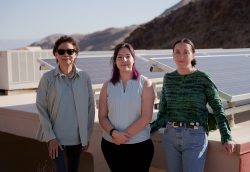
From left to right, Sandra Begay, a Sandia National Laboratories engineer and member of the Navajo Nation; Sarah LaVallie, an intern in the tribal energy internship program and a member of the Turtle Mountain Band of Chippewa Indians; Rachel Herring, another year-round intern and a member of the Choctaw Nation; at the Agua Caliente Band of Cahuilla Indians’ off-grid solar-powered trading post. Sandia’s tribal energy internship program has provided two decades of real-world experience for Native and Alaska Native STEM students.
July 13th, 2022 – 2022 marks a major milestone for Sandia National Laboratories’ groundbreaking tribal energy internship program: two decades of meeting the growing renewable energy technical needs of Native American tribes and providing valuable, real-world experience for Native and Alaska Native STEM students.
“My hope for the interns is for them to be leaders in clean energy, leaders in sustainable development, leaders in renewable energy projects,” said engineer Sandra Begay, who created the program in 2002 and is a member of the Navajo Nation. “I also hope that they have a little bit easier path than what I’ve had. I enjoy having a relationship with the interns beyond the internship program; I want to help them in their academic endeavors and also when they choose what they want to do with their life.”
Since its inception, the program has provided valuable experiences for 47 undergraduate and graduate science, technology, engineering and math students, approximately two-thirds women, from 24 different Native American and Alaska Native tribes. The internship program is sponsored by the Department of Energy’s Office of Indian Energy Policy and Programs.
Value of the tribal energy internship program
The core of the internship program is a full-time, 90-day summer experience where Begay passes down her decades of experience working with tribes on renewable energy projects, in turn the interns bring in the latest knowledge from their classes and their different experiences. Each student works on a research paper and final presentation that builds off of their academic background and tribal membership.
In addition to the summer interns, Begay also has interns who work for her part-time all year, while also taking classes. This year she has three summer interns and two year-round interns.
“I’ve always been interested in renewable energy, but this internship program has really given me a sense of purpose in what I want to do,” said Sarah LaVallie, a year-round intern in the program who is pursuing a master’s degree in science, technology and environmental policy from the University of Minnesota and is a member of the Turtle Mountain Band of Chippewa Indians. “Through this program I’ve been able to meet some of my greatest mentors and it’s been a great way to learn about tribal renewable energy projects. Getting to see some of these projects that I’ve been reading about for years was really cool and getting to learn some of the reasons why tribes decided to pursue renewable energy.”
After their internships, approximately 20% of prior interns stayed at Sandia as year-round interns, while about 11% were eventually hired as Sandia employees. Other interns have gone on to work at the DOE Office of Indian Energy Policy and Programs; form a nonprofit to bring solar installation, maintenance and support to native communities across the country; work as an engineer for the Navajo Tribal Utility Authority overseeing projects of more than 150 megawatts of solar power; and become a professor. More broadly, about half of the interns have pursued research directly related to renewable energy in Indian Country, 36% remained in STEM fields and 4% work for or started nonprofits.




